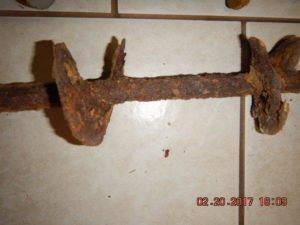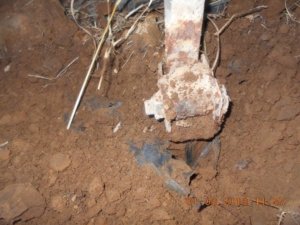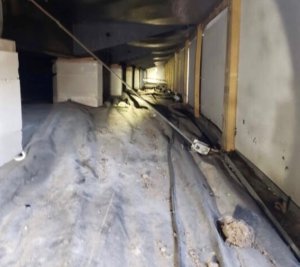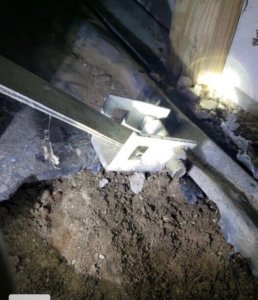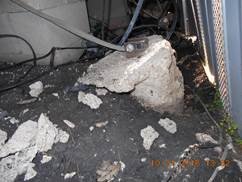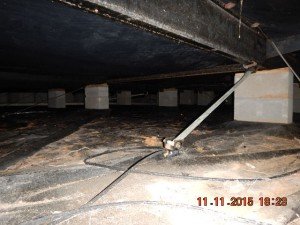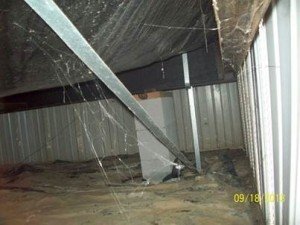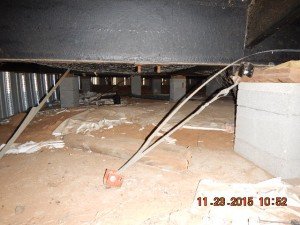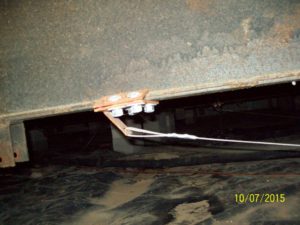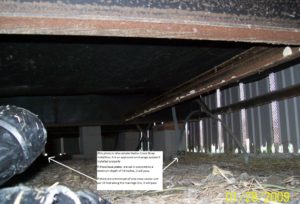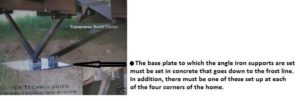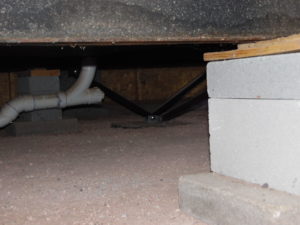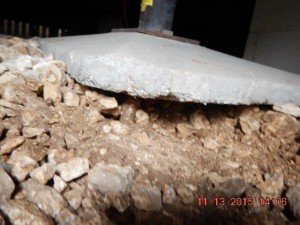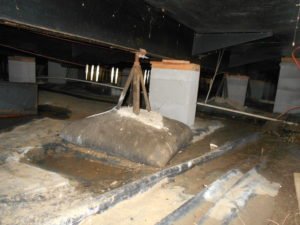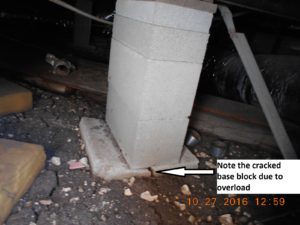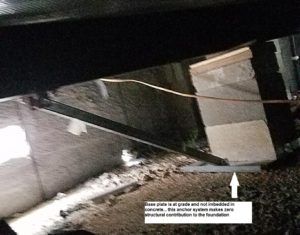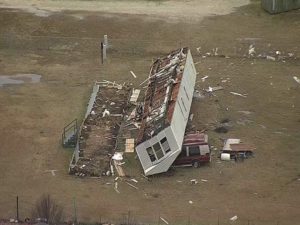Mobile Home Anchors & Straps
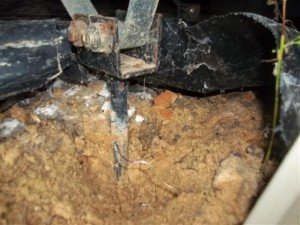
(1) Our inspector took this inspection photo of a non-compliant anchor. notice that there is no concrete around the anchor stem or head.
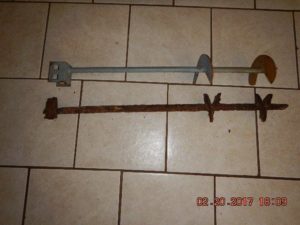
(1a) This is an inspection photo of anchor stems used to anchor the mobile home to the ground. Both anchors are 31 inches in length. The bottom anchor had been in ground less than 4 years with no concrete collar and already was severely corroded. The top anchor is what the bottom anchor originally would have looked like.
(1b) Close-up inspection photo of the anchor that had been in ground less than 4 years with no concrete collar and already severely corroded.
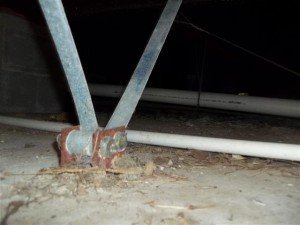
(2) Our inspector took this inspection photo of an FHA/HUD compliant anchor… notice that the anchor stem and head is set in concrete.
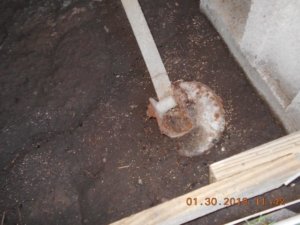
(3) Our inspector took this photo of a corrosion-resistant galvanized anchor that started to be used in 2012/2013 by some installers. It is corrosion resistant and thus meets FHA/VA/USDA/HUD as well as Texas TDHCA Guidelines.
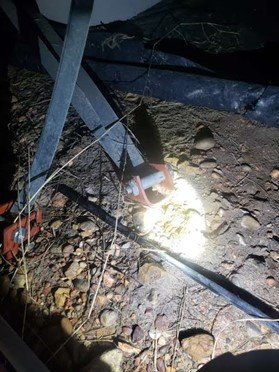
(3b) This inspection photo shows what happens when the spacing of the anchors is too great and there is not enough wind resistance. Over a period of time, the anchor and its concrete collar have been pulled out of the ground and neutralized as a structural element of the foundation
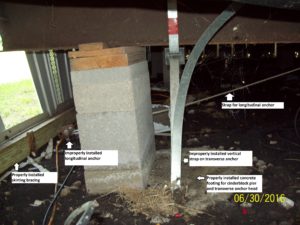
(3c) Our inspector took this inspection photo that shows several issues addressed in the FHA/VA/HUD 1996 Guidelines for Manufactured Home Foundations
- The transverse anchor is set in concrete but the straps are vertical… the straps should have been run to the interior frame
- The longitudinal anchor is set in soil… it should have been set in the concrete footing on which the transverse anchor is set
- The concrete footing appears to be in satisfactory condition
- The skirting bracing is also set properly.
(4) Properly installed longitudinal anchor. The anchor stem is embedded in concrete (the same longitudinal concrete runner on which the cinderblock pier is set ), the strap is at a reasonable angle and secured to the frame properly.
This type of system has the anchors along the marriage line but no anchors on the exterior frames.
If the number of anchor sets is the same as would be installed on the exterior frame (6 to 10, spaced 8 to 10 feet apart, depending on length) and the anchor plate is set in concrete that extends past the frost line, then it does meet the intent of the 1996 HUD Guidelines. No longitudinal are needed for such a properly installed system.
From a maintenance view, however, it is inferior to properly installed exterior frame transverse and longitudinal anchor system. The lack of exterior restraints means there will be impact forces on the exterior cinderblock piers that will cause them to fracture and fail over a period of time and need to be replaced.
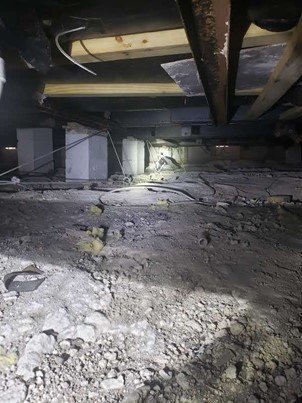
(5) In this inspection photo, the anchor stem is embedded in the same concrete footing onto which the cinderblock pier is set. One strap goes almost vertical to the exterior frame and the other strap extends to the interior frame at an angle ranging from 30 to 45 degrees from horizontal. This anchor arrangement meets FHA/VA/USDA/HUD as well as Texas TDHCA guidelines
(6) Another recent example of both a transverse and a longitudinal anchor properly installed. Notice that both anchor stems are set in the concrete longitudinal runner. Note also that the transverse anchor has the strap running at an angle to the interior frame and not vertical to the exterior frame.
(7) Our inspector took this inspection photo as an sample close-up of how a longitudinal anchor strap is attached to the frame of the home.
(7a) Sample Cross Vector Strap anchorage system. Our inspector took this inspection photo showing a sample Vector Cross Strap installation. It is an approved anchorage system if installed properly. If the base plates are set in concrete to a minimum depth of 14 inches, it will pass. If there are a minimum of one cross vector unit per 16 feet along the marriage line, it will pass.
(7b) Our inspector took the above inspection photo of a anchoring system that does meet FHA/VA/HUD and Texas TDHCA guidelines if installed properly.
(7c) The above type anchor system must also be set
1. at all four corners for a doublewide and
2. at each end for a singlewide
It would also be preferable if the mild steel shown in this photo were coated with a corrosion resistant paint to inhibit rust and extend the life of the system.
(8) This type foundation is variously called a Magnum or Bigfoot Manufactured Home Foundation Pier. If the base plate is secured to a concrete footing that goes down at least 12 inches into the ground, it will pass. However, there are many cases, such as the one in the photo above, where the base is simply setting on the ground and does not pass. In addition, this pier must be set at all four corners of the home, at a minimum, in order to pass.
(8a) Non-compliant anchor system.
The anchor system in this inspection photo would be compliant if the pad were set in concrete that was at least 12 inches deep. Instead, the pad is simply sitting on the ground at grade and contributes effectively zero wind resistance for the home
(8b) This inspection photo shows what can happen when a single pier is overloaded and near failure. The height of this pier should have required double-stacked cinder blocks and also a concrete footing under the pier to provide stability.
(8c) Another example of an improperly installed BigFoot or equivalent system. If the base plate had been embedded in a concrete footer extending a minimum of 8 inches below grade (preferable 12 inches ), it would have passed.
An example of why anchors and straps are critically important to your home.
Notice two things:
- The straps that were there but too rusted to hold the home in place and
- The tool shed at the top right corner, set on a proper foundation, that remained intact during the same wind storm.

